- Home
- Patti Smith
Devotion_Why I Write
Devotion_Why I Write Read online
DEVOTION
DEVOTION
PATTI SMITH
The Why I Write series is published with assistance from the Windham-Campbell Literature Prizes, which are administered by the Beinecke Rare Book and Manuscript Library at Yale University.
Copyright © 2017 by Patti Smith. All rights reserved.
This book may not be reproduced, in whole or in part, including illustrations, in any form (beyond that copying permitted by Sections 107 and 108 of the U.S. Copyright Law and except by reviewers for the public press), without written permission from the publishers.
Yale University Press books may be purchased in quantity for educational, business, or promotional use.
For information, please e-mail [email protected] (U.S. office) or [email protected] (U.K. office).
Printed in the United States of America.
Library of Congress Control Number: 2017933005
ISBN 978-0-300-21862-6 (hardcover : alk. paper)
A catalogue record for this book is available from the British Library.
This paper meets the requirements of ANSI/NISO Z39.48-1992 (Permanence of Paper).
10 9 8 7 6 5 4 3 2 1
To Betsy Lerner—
my friend and guide
CONTENTS
How the Mind Works
Devotion
A Dream Is Not a Dream
DEVOTION
Inspiration is the unforeseen quantity, the muse that assails at the hidden hour. The arrows fly and one is unaware of being struck, and that a host of unrelated catalysts have joined clandestinely to form a system of its own, rendering one with the vibrations of an incurable disease—a burning imagination—at once unholy and divine.
What is to be done with the resulting impulses, these nerve endings flickering like an illuminated map of thieving constellations? The stars pulse. The muse seeks to be vivified. But the mind is also the muse. It seeks to outsmart its glorious opponents, to rewire such sources of inspiration. A crystal stream suddenly dried. A thing of beauty joyless, defiled. Why does the creative spirit turn on itself? Why does the maker twist all drama? The pen is lifted, guided by the shattered muse. Without discord, it marks, harmony passes unnoticed, without discord, it continues, Abel is rendered no more than a forgotten shepherd.
How the Mind Works
WRITING DESK, NEW YORK CITY
1
Somehow, searching for something else, I stumbled upon a trailer of a film called Risttuules, translated as In the Crosswind. It is Martti Helde’s requiem for thousands of Estonians who suffered mass deportation to Siberian collective farms in the spring of 1941, when Stalin’s troops rounded them up, separated families, and herded them into cattle cars. Death and exile, their fate reassigned.
The filmmaker created a visual poem through a unique dramatization of actors winding through a set of stationary human tableaus. Time suspends yet rushes, spreading images in the form of words drawn from this sad pageant. A terrible gift, I acknowledge as I write, straining to get the words down. Yet even so, I sense that behind them something else is brewing. I follow a mental line and come upon a forest of firs and a pond and a small clapboard house. This was the beginning of that something else, but I didn’t know it then.
A winter sketch. Just a road away. A blue dressing gown is a curtain for a window that no one will see through again. There is blood everywhere, drained of its blood color, and a dog barking and stars dropping through pallid skies.
A dying calf. A splint upon the hoof—smears, holes. Night falls, obscuring the twitching limb of the last living thing.
A sketch on time. Gears, small hands in ice suspend. Birds no longer curious cease to wing. The dance is over and the face of love is nothing but the wide skirt and burnished heels of winter.
In the morning I awake with the black-and-white dioramas of Risttuules still in my mind, the strained tempo of the human opera embodied in bowed and breathing statues. So taken by its expressive power I cannot recall the objective of my original search. I lay there replaying a slow pan of the banished human chain winding through a relentless flurry of white petals. Chrysanthemums. Yes! Branches of them and the wretched train of life blurring past. Yet returning to the same bit of film I had viewed earlier, I find no such scene. Had I unwittingly projected it? I push aside my computer and cast a ruling upon the uneven plaster ceiling: we pillage, we embrace, we know not. I get up to urinate. I imagine snow.
With the delicate voice of Erma, the female narrator of Risttuules, fresh in my ear, I dress, grab my notebook and a copy of Patrick Modiano’s Paris Nocturne, and cross over to the neighborhood café. Workers are jackhammering the street, the deafening vibrations pervade the walls of the café. Unable to write, I read, traipsing the Nocturne network—uncertain streets, fragments of addresses, routes no longer relevant, and events that add up to a circle of nothing. I lament not writing but figure losing oneself in the energized torpor of the Modiano universe is almost like writing. You enter the skin of the narrator with his pale sense of paranoia and preoccupation with minutiae and the space around you shifts. Inevitably somewhere midsentence, I find myself reaching for my pen.
Reaching the end of Nocturne, though not really an end, as vapors of future seep beyond the last page, I reread the beginning, then fast-forward to my own day ahead. I am set to leave on the last flight to Paris. My French publisher has arranged a week of book-related events that include speaking to journalists about writing. My notebook remains untouched. A writer who isn’t writing going to talk with journalists about writing. What a know-it-all, I chide myself. I have another black coffee and a bowl of blueberries. There is plenty of time and I am a light packer.
The street a construction zone, I am obliged to wait before crossing back home while a massive crane hoists metal support beams several floors above the café, bringing to mind the opening scene in La Dolce Vita where a helicopter transports a life-size figure of Christ above the urban rooftops of Rome.
I gather my usual things for travel, setting them in a pile next to my small suitcase as I listen again to the voice-over of the trailer. The lilt of an unfamiliar language implies the saddest of melodies suffusing. As troops advance, a young mother hangs clothes and shields her eyes from the sun. Her husband is separating the wheat from the chaff, her daughter happily at play. Intrigued, I search a bit more and find a six-minute cut from Risttuules subtitled The Birch Letter. A shot of an open window, images of whiteness and birch trees emerging through whispered phrases and a train and the wind and the void.
The phone rings, breaking the spell, my flight canceled. I have to make an earlier one. I swiftly get in gear, call a taxi, slide my computer in its case, camera in a sack, and cram the rest into the suitcase. The taxi arrives too quickly as I realize I haven’t yet chosen what books to take. The prospect of boarding a plane without a book produces a wave of panic. The right book can serve as a docent of sorts, setting a tone or even altering the course of a journey. I desperately scan the room as if searching for a lifeline in a deep marsh. Among a small pile of unread books atop my flat files are Francine du Plessix Gray’s monograph on Simone Weil and Modiano’s Pedigree, with the astonished face of the author on the cover. I snatch them up, say goodbye to my little Abyssinian cat, and head to the airport.
Luckily traffic is thin as we enter the Holland Tunnel. Relieved, I sink back into the voice of Erma. I imagine writing a story guided by the atmosphere conjured by the resonance of a particular human voice. Her voice. No plot in mind, just trailing her tones, timbres, and composing phrases, as if music, and superimposing them, transparent layers, over hers.
And the face of love is nothing but the whiteness of winter blanketing limbs of trees fallen through holes colorless skies.
I hurry through the terminal, easily making my flight yet somewhat thrown off. There is no hope of falling asleep this early, to say nothing of the fact that my hotel room won’t be ready for several hours after I arrive. Nonetheless I settle in, drink mineral water, and let myself be drawn into the book of a life, a shard of Simone Weil. The hastily chosen book was to prove itself more than serviceable and the subject an admirable model for a multitude of mindsets. Brilliant and privileged, she coursed through the great halls of higher learning, forfeiting all to embark on a difficult path of revolution, revelation, public service, and sacrifice. I had not as yet dedicated time or study to her, but that would surely change. Closing my eyes, I envision the tip of a glacier and slide into an intimate hot spring surrounded by walls of impenetrable ice.
ÉGLISE DE SAINT-GERMAIN-DES-PRÉS
2
I pass through customs and sleepily exit the terminal at Paris-Orly. My friend Alain awaits me. I check into my hotel located on a narrow street just steps away from the church in Saint-Germain-des-Prés. As they prepare my room, we have baguettes and coffee at Café de Flore.
Saying goodbye, I enter the small park adjacent to the church with Picasso’s bust of Apollinaire at the entrance. I sit on the same bench where I had sat with my sister in the spring of 1969. We were in our early twenties, when everything, including the sentimental head of the poet, was a revelation. Inquisitive sisters with a handful of precious addresses of cafés and hotels. The Deux Magots of the existentialists. The Hôtel des Etrangers, where Rimbaud and Verlaine presided over the Circle Zutique. The Hôtel de Lauzun with its chimeras and gilded halls where Baudelaire smoked hashish and penned the opening poems in Les fleurs du mal. The interior of our imaginations glowed, as we walked back and forth before these places synonymous with poets. Just to be near where they had written, sparred, and slept.
It is suddenly chilly. I notice bits of bread, relentless pigeons, a young couple’s languorous kisses, and a homeless fellow with a long beard in an overcoat seeking a few coins. Our eyes meet and I get up and walk toward him. His eyes are grey and he reminds me of my father. A silvery light seems to spread over Paris. I feel a wave of nostalgia induced by the perfect present. It begins to drizzle. Grainy bits of film swirl. The Paris of Jean Seberg in a striped boatneck shirt hawking the Herald Tribune. The Paris of Eric Rohmer, standing in the rain in the Rue de la Huchette.
Later in the hotel, struggling to stay awake, I open the Weil biography at random, nod off briefly, then pick up in an entirely new section, the process somehow animating the subject. Simone Weil walking brusquely into the frame from the third dimension. I see the edge of her long cloak and her thick dark hair brutally cropped like that of the brilliant, independent bride of Frankenstein.
Yet another image of Simone flits past my eye, a caricature like those of the voyagers to Mount Analogue sketched by René Daumal. Heart-shaped face, hair horizontally jutting, dark probing eyes behind round wire-rim glasses. They knew each other and he had taught her Sanskrit. I picture the consumptive pair, their heads barely touching, poring over ancient texts, their failing systems thirsting for milk.
The hand of gravity is pulling me under. Switching on the TV, I flip through channels, stopping at the tail end of a documentary on the staging of Racine’s Phaedra, then fall into a heavy asleep. A few hours later I suddenly open my eyes. On the screen a girl on ice. Some kind of figure skating championship. A sturdy blonde finishes her program successfully. The girl following her is charming but has a bad fall and cannot regroup. I remember watching such competitions with my father, sitting at his feet while he brushed my tangled hair. He admired the athletic skaters, I the graceful ones who seemed to incorporate classical ballet.
The last skater is announced, a sixteen-year-old Russian, the youngest in competition. Despite being half awake I give her my full attention. A young girl steps onto the ice as if nothing else exists. Her single-minded purpose, combination of innocent arrogance, awkward grace, and daring is breathtaking. Her triumph over the others brings me to tears.
In my sleep genius combines, regenerates. Simone’s determined heart-shaped face merges with the face of the young Russian figure skater. Dark cropped hair, dark eyes penetrating darker skies. I climb the side of a volcano carved from ice, heat drawn from the well of devotion that is the female heart.
I wake early, walk over to Café de Flore and have a plate of ham and eggs and black coffee. The eggs are perfectly round, set upon a perfectly round slab of ham. I marvel how genius manifests, in a plate of eggs or the center of a rink. Alain joins me and we head over to 5, Rue Gaston-Gallimard, the publishers’ headquarters since 1929. My editor Aurélien opens the door to Albert Camus’s former office. From the sole window a view of the garden below. Displayed in a case are books of Simone Weil’s, posthumously published under his direction. Lettre à un religieux, La connaissance surnaturelle, and L’enracinement.
Mr. Gallimard greets me in his office. On the mantle is the clock that Saint-Exupéry had presented to his grandfather. We descend worn marble stairs, pass through the blue salon, and enter the garden where Yukio Mishima was photographed sitting in a white rattan chair. We stand for several moments silently admiring the garden’s geometric simplicity.
It brings to mind other gardens, like stereo cards streaked with time. The centuries-old Orto Botanico in Pisa with its forgotten statue of Humboldt and towering Chilean wine palms. The Garden of Simples, with its wild medicines, where consciousness alternately expands and finds peace. I think of Joseph Knecht, alone in the unassuming garden of scholars, contemplating his future as Magister Ludi. The garden at Schiller’s summer home in Jena, where Goethe was said to have planted a gingko tree.
—I knew Genet, Mr. Gallimard says softly, looking away so as not to appear immodest.
I am lured by a number of spirals carved on the high wall to the right. They resemble the spiral Brancusi created to represent James Joyce for the small Black Sun edition of Tales Told by Shem and Shawn. I linger, content to be with the ghosts of writers who have passed into this same perimeter. Camus leaning against the wall smoking cigarettes. Nabokov reflecting on the curve of the Nautilus.
GALLIMARD GARDEN
That night I dreamt I knew how to swim. The sea was cold, but I had a coat on. I awoke shivering, having left the window open to look at the church before I turned in. I could see the church from my window and thus a long stretch of my life. I had first seen this church with my sister in late spring of 1969. We entered it together somewhat timidly and lit candles for our family.
I get up to close the window. It is raining, silent steady rain. I suddenly begin to cry.
—Why are you crying? Asks a voice.
—I don’t know, I answer. Maybe because I’m happy.
Paris is a city one can read without a map. Walking down the narrow Rue du Dragon, old Sépulcre Street, which once boasted an imposing stone dragon. No. 30 a plaque in memory of Victor Hugo. Rue de l’Abbaye. Rue Christine. No. 7, Rue des Grands Augustins, where Picasso painted Guernica. These streets are a poem waiting to be hatched—suddenly it’s Easter; eggs everywhere.
I walk aimlessly, finding myself in the Latin Quarter, then cut over to Boulevard Saint-Michel, searching for number 37, where Simone was raised and the Weil family lived for decades. I have a flash of Patrick Modiano tracing one address after another, crisscrossing the entire city in search of a certain stairway. I think of Albert Camus, about to receive the Nobel Prize, making this same pilgrimage to the Weil residence, but for graver reasons—not mere curiosity but contemplation.
A burgeoning routine. Awake at seven. Café de Flore at eight. Read until ten. Walk to Gallimard. Journalists. Book signing. Lunch with the Gallimard crew—Aurélien, Cristelle, duck confit and beans, local café fare. Tea in the blue salon, the garden beyond, interviews. A journalist hands me a book on Simone Weil, translated into English. Do you know of her, she asks. Later a journalist named Bruno presents me with an image of G�
�rard de Nerval, which I place on my night table. It is the same melancholy portrait I had taped above my desk when in my twenties.
Alain and I meet in the evening and have a light meal as he briefs me on our journey in the morning to southern France. A book presentation is scheduled in Sète, an old seaside resort on the Mediterranean, the native town of the poet Paul Valéry. Happy with the prospect of visiting a new place and breathing the salt air, I return to my room, pack light, and then attempt to cajole myself to sleep, reciting my mantra: Simone and Patrick. Patrick and Simone. He imbues anxious calm. She fills me with adrenaline, dangerously familiar.
I wake earlier than usual, arrive at the Flore just as it opens, order a baguette with fig jam and a black coffee. The bread is still warm. On the way to the train I recheck the contents of my sack. Notebook, Simone, underwear, socks, toothbrush, a folded shirt, camera, my pen and dark glasses. Everything I need. I have hopes of writing but instead stare sleepily out the train window, noting the changing landscape as we pass from the graffiti-scrawled walls in the outskirts of Paris to more open spaces, sandier ground, scruffy pine, and finally the pull of the sea.
CUTLERY. CAFÉ DE FLORE
In Sète we have fresh seafood at a local café overlooking the harbor. Alain and I walk up a hill to the cemetery in search of Paul Valéry. We find him and pay respects, but the grave of a young girl named Fanny who loved horses also beckons. Friends and family have placed horses on her headstone, forming a little stable undisturbed by weather or vandal. Drawn to yet an older headstone, I note the word DEVOUEMENT carved diagonally on the border. I ask Alain what it means.
—Devotion, he answers, smiling.

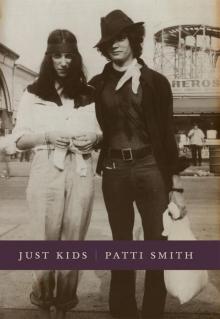 Just Kids
Just Kids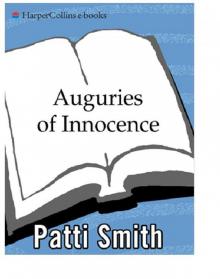 Auguries of Innocence
Auguries of Innocence Devotion
Devotion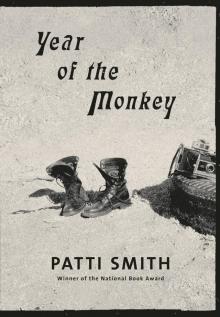 Year of the Monkey
Year of the Monkey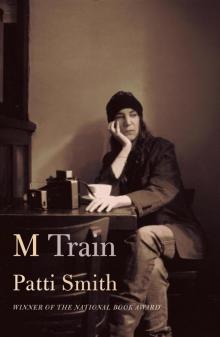 M Train
M Train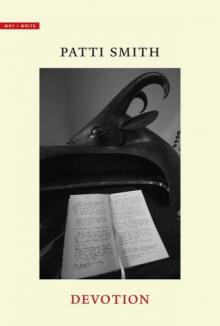 Devotion_Why I Write
Devotion_Why I Write